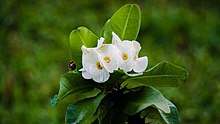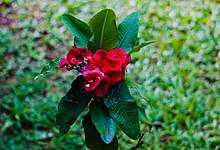Pascua Florida
Pascua Florida (pronounced [ pas-kua ] is a Spanish term that means "flowery festival" or "feast of flowers" and is an annual celebration of Juan Ponce de Leon's arrival in Florida.[1] [2] While the holiday is normally celebrated on April 2nd, it can fall on any date between the latter parts of March and the first week of April, depending on the day of the week April 2nd falls on and/or the Governor's discretion.[3] Pascua Florida Day is a State Holiday. [4]

Background

Juan Ponce de Leon is the first known European to come to the state that is now known as Florida.[5] His successful discovery of Puerto Rico during one of many Spanish expeditions for gold, mystical items and new lands, precipitated Spain's permission and encouragement to claim more lands in the new world.[6] One such mystical item that lured him to what eventually happened to be Florida, was the Fountain of Youth.[7][8]
Juan Ponce de Leon became governor of Puerto Rico during the early 1500s.[9] [10]The natives told him of an island that was rich in gold and had a magical fountain of water which would renew a person's health and youth.[11] Intrigued, Ponce de Leon returned to Spain to seek the approval of the Spanish crown to search and explore the island, known by natives as Bimini.[8] On February 23 of 1512, King Ferdinand approved Ponce de Leon's request to search for the island and by the 3rd of March in 1513, three ships left the Port of San German in Puerto Rico to search for the island of Bimini.[9] He landed on Floridian shores some time during April 2 to April 8 and named the area "la Florida" in honor of "Pascua Florida", Spain's Easter time celebration,because of the vast expanse of floral plants he encountered.[3] The expedition believed their discovery to be a large island and Ponce de Leon named the 'island' Pascua Florida.[8]
History of Holiday
History and Significance
Pascua Florida Day commemorates the arrival of Juan Ponce de Leon on the shores of the state of Florida in 1513.[1][3][2] Florida is now known as the "Flower State" because of the connection to Ponce de Leon and Pascua Florida.[3] Since its entry into legislature, the holiday, while having no specific celebratory acts, usually culminates in a period of retrospection of Florida's rich history and the preceding events that led to it.[3]
Celebration
Pascua Florida Day is only celebrated in Florida. The holiday was adopted into Florida law on April 2 of 1953 at the suggestion of Mary A. Harrell, a Social Studies teacher in Jacksonville, Florida.[3] From that point on, the week within which the holiday falls, usually March 27 to April 2, is dubbed Pascua Florida Week to honor Florida's history, and school children and adults alike, are urged to observe the time by partaking in commemorative exercises and programs. [3]
Pascua Florida Day
Pascua Florida Day is usually celebrated on April 2 (the day on which Ponce de León first spotted Florida) unless it falls on a weekend, in which case the governor may declare either the preceding Friday or the following Monday as the state day.[12] The Governor of Florida may issue an annual proclamation designating April 2 as the state day and designating the week of March 27 to April 2 as "Pascua Florida Week" and calling upon public schools and citizens of Florida to observe the same as a patriotic occasion.[13]
References
- Florida Statutes, Section 683.06
- Definitions for pascua
- "European Exploration and Colonization - Florida Department of State". dos.myflorida.com. Retrieved 2020-03-20.
- Editors, History com. "Ponce de Leon claims Florida for Spain". HISTORY. Retrieved 2020-03-20.CS1 maint: extra text: authors list (link)
- Hatch, Jane M. (1978). The American book of days. The H. W. Wilson Company. ISBN 0-8242-0593-6. OCLC 953162536.
- "Florida State Holidays". Employment Law Handbook. Retrieved 2020-03-20.
- "Juan Ponce de Leon | Biography, Route, & Facts". Encyclopedia Britannica. Retrieved 2020-03-20.
- "Juan Ponce de Leon | Biography, Route, & Facts". Encyclopedia Britannica. Retrieved 2020-03-20.
- "Juan Ponce de Leon | Biography, Route, & Facts". Encyclopedia Britannica. Retrieved 2020-03-20.
- Koch, Peter O., 1953- (2009). Imaginary cities of gold : the Spanish quest for treasure in North America. McFarland & Co. ISBN 978-0-7864-4381-9. OCLC 277136415.CS1 maint: multiple names: authors list (link)
- Koch, Peter O., 1953- (2009). Imaginary cities of gold : the Spanish quest for treasure in North America. McFarland & Co. ISBN 978-0-7864-4381-9. OCLC 277136415.CS1 maint: multiple names: authors list (link)
- "Juan Ponce de Leon | Biography, Route, & Facts". Encyclopedia Britannica. Retrieved 2020-03-20.
- "Juan Ponce de Leon | Biography, Route, & Facts". Encyclopedia Britannica. Retrieved 2020-03-20.
- "Chapter 683 Section 06 - 2018 Florida Statutes - The Florida Senate". www.flsenate.gov. Retrieved 2020-03-20.
- "Chapter 683 Section 06 - 2018 Florida Statutes - The Florida Senate". www.flsenate.gov. Retrieved 2020-03-20.
| Look up florida in Wiktionary, the free dictionary. |
| Look up pascua in Wiktionary, the free dictionary. |